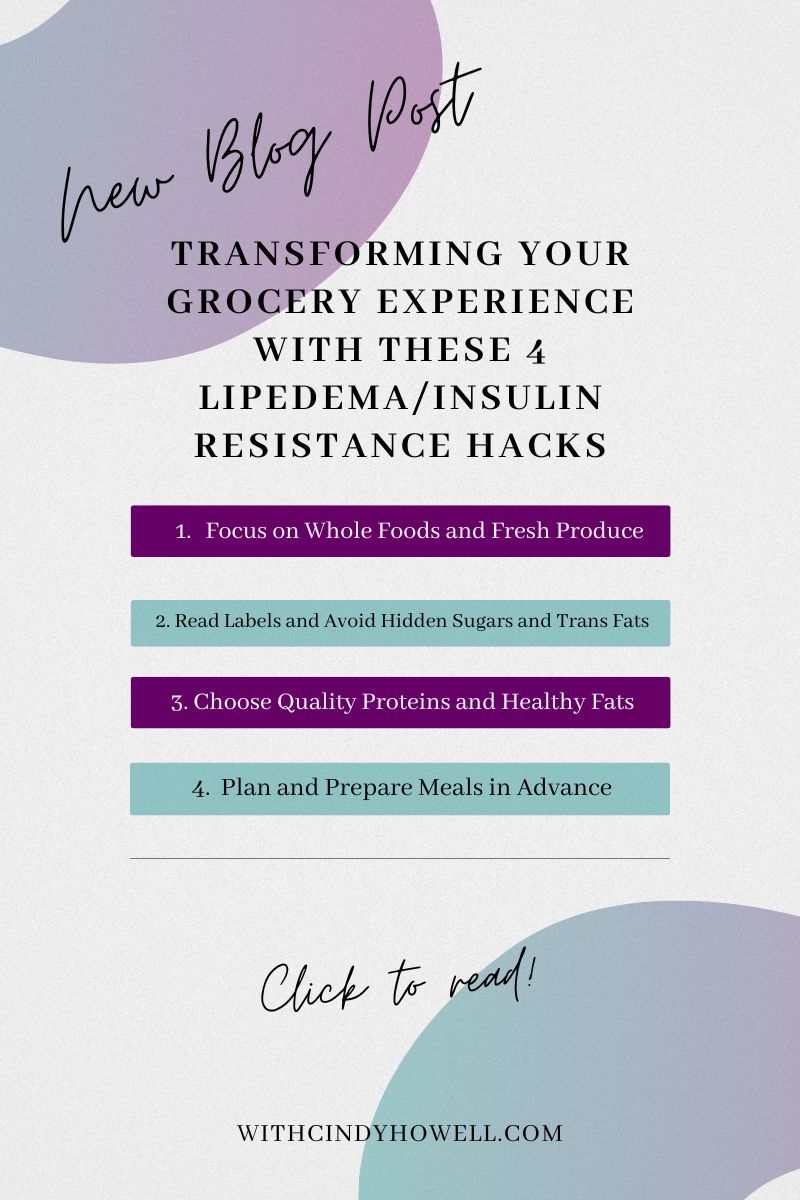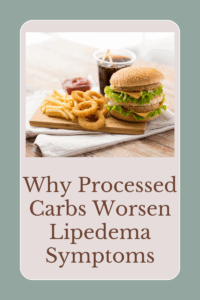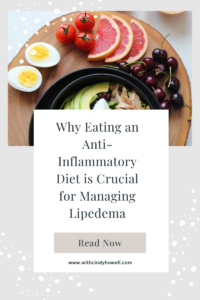Grocery shopping can become a daunting task for those navigating the complexities of lipedema and insulin resistance. These two conditions often demand a thoughtful approach to eating habits, which can significantly impact overall health. However, with the right strategies, your trips to the store can be both rewarding and empowering. In this guide, we’ll uncover why nutrition matters so much for those managing lipedema and insulin resistance and share five practical tips to help you make smarter choices.
Understanding Lipedema and Insulin Resistance
What is Lipedema?
Lipedema is a chronic condition characterized by an abnormal accumulation of fat, typically in the hips and legs. This condition is often painful and can lead to swelling. The exact cause is not fully understood, but it’s thought to have a genetic component. Managing lipedema involves more than just medical treatment; lifestyle choices, especially diet, play a vital role.
Delving into Insulin Resistance
Insulin resistance occurs when cells in your muscles, fat, and liver don’t respond well to insulin and can’t easily take up glucose from your blood. This can lead to higher blood sugar levels, eventually resulting in type 2 diabetes if not managed properly. Like lipedema, diet is a crucial factor in managing insulin resistance.
The Connection Between the Two
Both conditions are linked to how the body processes food. While lipedema involves fat distribution, insulin resistance impacts how sugar is processed. Therefore, a balanced diet that addresses both conditions can help manage symptoms and improve quality of life.
The Role of Nutrition in Managing Lipedema and Insulin Resistance
Importance of Diet
Diet plays a significant role in treating lipedema and insulin resistance. The right foods can help control weight, manage blood sugar levels, and reduce inflammation. By focusing on a nutrient-rich diet, individuals can work toward better health outcomes.
Foods that Make a Difference
Incorporating specific food types can aid in managing these conditions. For instance, whole foods, rich in fiber and antioxidants, can help maintain a healthy weight and support insulin sensitivity. On the other hand, processed foods high in sugar and unhealthy fats should be avoided.
Personalizing Your Diet
Since everyone’s body reacts differently, it’s essential to tailor your diet to your needs. Some might find success with low-carb diets, while others may benefit from a Mediterranean-style eating plan. Consulting with a healthcare provider or dietitian can help create a personalized approach. Personalize you diet and life style with a certified health coach specializing in lipedema and insulin resistance.
Navigating the Grocery Store with Confidence
Tip 1: Focus on Whole Foods and Fresh Produce
Whole foods are minimally processed and packed with nutrients. When shopping, prioritize protien, fresh low glycemic fruits, non starchy vegetables,. These foods provide essential vitamins, minerals, and fiber, supporting overall health.
Visit the produce aisle and choose a variety of colors to ensure you’re getting a range of nutrients. Leafy greens, berries, and cruciferous vegetables are excellent choices for those managing lipedema and insulin resistance.
Tip 2: Read Labels and Avoid Hidden Sugars and Trans Fats
Food labels can be your best friend or worst enemy. Always read them carefully to spot hidden sugars and trans fats. These ingredients can exacerbate insulin resistance and worsen lipedema symptoms.
Look for foods with minimal added sugars. Ingredients like corn syrup, fructose, and dextrose are indicators of extra sugars. Opt for natural sweeteners like stevia or monkfruit when possible. The best would be to avoid sugars all together.
Trans fats, often found in processed snacks and baked goods, should be avoided. These unhealthy fats can increase inflammation and contribute to weight gain, making them especially problematic for individuals with lipedema and insulin resistance.
Tip 3: Choose Quality Proteins and Healthy Fats
Proteins and fats are crucial components of a balanced diet. When selecting proteins, you can eat any kind you like, as long as there is not added sugar or toxins. Beef, Chicken, Pork and Seafood.
Healthy fats, found in foods like avocados, nuts, and olive oil, are beneficial. They help reduce inflammation and support heart health, which is particularly important for those dealing with insulin resistance.
Including these in your meals can keep you full longer, reducing the temptation to snack on unhealthy options. Plus, they add flavor and satisfaction to your dishes.
Tip 4: Plan and Prepare Meals in Advance
Meal planning is a powerful tool for maintaining a healthy diet. By planning your meals ahead of time, you can ensure that you’re eating balanced, nutritious foods consistently.
Start by creating a weekly menu that includes a variety of meals. Then, make a shopping list based on your planned meals to avoid impulse buys of unhealthy options.
Preparing meals in advance means you’ll always have healthy options on hand. This reduces the likelihood of reaching for quick, processed snacks when hunger strikes.
Practical Strategies for Implementing the Tips
Making a Shopping List
Before heading to the store, make a detailed shopping list. This helps you stay focused and resist the temptation to purchase items that don’t align with your dietary goals.
Use your list to plan meals that incorporate the tips mentioned above. This ensures you’re buying what you need and sticking to nutritious choices.
Creating a list also saves time and reduces stress, making grocery shopping a more enjoyable experience.
Finding the Right Stores
Not all stores offer the same quality and variety of products. Research local stores to find those that provide fresh, whole foods and a good selection of healthy options.
Consider farmers’ markets for fresh produce and specialty stores for unique, health-focused items. These places often offer better quality and can inspire you to try new foods.
Shopping at the right stores can enhance your ability to stick to your dietary plan and discover new favorites along the way.
Empowerment Through Education
Understanding the impact of your diet empowers you to make choices that align with your health goals. Education is key to transforming your grocery shopping experience and overall well-being.
Engage with resources, attend workshops, and connect with communities focused on healthy eating to broaden your knowledge.
Encouraging Community Support
Joining a community of like-minded individuals can provide support and motivation. Share tips, recipes, and experiences to help each other succeed on your health journeys.
Communities foster a sense of belonging and accountability, making it easier to stick to your dietary goals.
Inspiring Your Shopping Journey
Grocery shopping doesn’t have to be a chore. With the right strategies, it can become an empowering experience that supports your health and well-being.
By focusing on whole foods, reading labels, choosing lean proteins, incorporating low-GI foods, and planning meals, you take control of your diet.
We’d love to hear from you! Share your own grocery shopping tips and experiences in the comments below. For more insights, explore our related content and take your health journey to the next level.
Supporting Your Wellness
OX Cindy
Ready to take your journey to the next level? Join the private Facebook community for exclusive support, practical tips, and a group of women who truly understand. Let’s empower each other to thrive—click here to join! https://www.facebook.com/groups/7021999704562921/
What my FREE checklist: Top 5 Food to Avoid for Managing Lipedema and Insulin Resistance! Click there Link:https://l.bttr.to/Eca4d
Looking for personalized guidance to manage lipedema and insulin resistance? Work with me one-on-one to create a tailored plan that fits your unique needs and empowers your health journey. Click here to learn more and get started today! https://l.bttr.to/WaDwK








